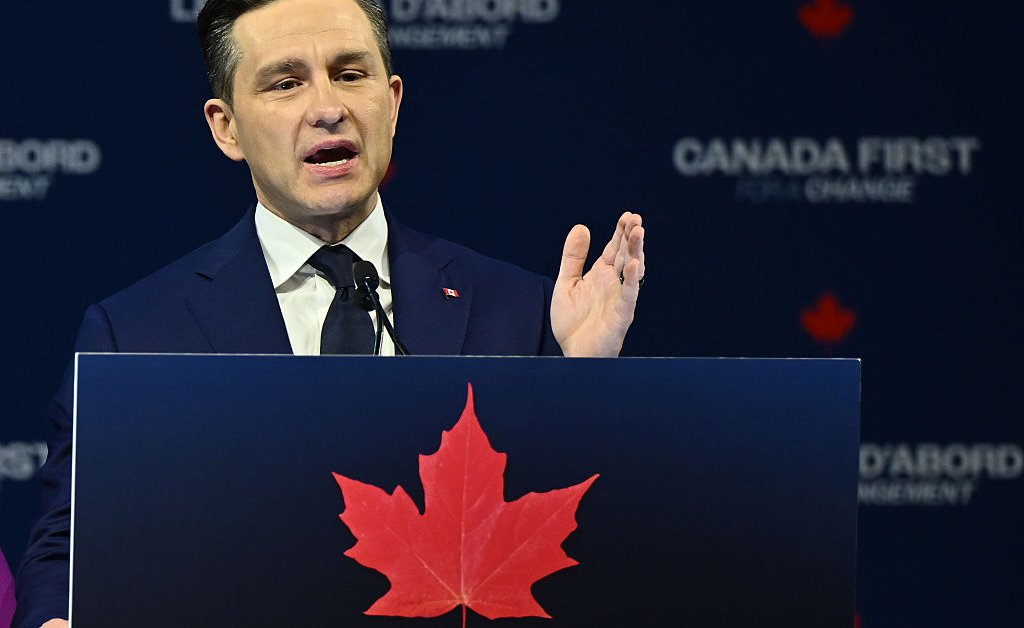Canada’s Pierre Poilievre is back after an election loss for the ages.
The Conservative Party leader won a by-election on Monday in Battle River-Crowfoot, a Tory electoral district in Alberta that he’s never lived in. He can finally return to Parliament after the embarrassment of losing his own seat of Carleton in Ottawa during the federal election in April, which saw the Conservatives blow a more than 20-point lead to a Liberal Party led by former central banker Mark Carney.
Poilievre won his by-election with 80% of the vote. A casual observer might assume there may be few demanding Poilievre quit as Tory leader with such a healthy margin, mistaking a single parliamentary district for the country—or the party. That’s a fair enough mistake. Some folks, including me, were making the case only months ago for him to stay on. After all, the Conservatives had managed a strong general election performance with 41% of the vote, but were punished by first-past-the-post. Poilievre was a steady hand who just had to wait for the Liberals to implode, which they would, eventually, as all Liberals do in time.
April gave way to May and June, and as summer settled in, the Liberals remained atop the polls as Carney continued to wrong-foot the Conservatives by giving them just about everything they wanted. There was something of a Greek tragedy to it, with Poilievre getting his way—the end of the unpopular carbon tax, lower taxes, lower internal trade barriers, and a government that was all-in on building big, national infrastructure projects. When Air Canada flight attendants went on strike in recent days, Carney’s labor minister asked the Canada Industrial Relations Board to order them back to work, a move one might have expected from Poilievre. Critics have been asking whether, with Liberals like these, one even needs Conservatives, or ones like Poilievre, at least.
Read More: Pierre Poilievre Is the Ron DeSantis of Canada
In January, Poilievre faces a leadership review, and now’s the time to ask if he should stay on. Increasingly, the answer is no. Of course, he won his by-election with ease. But it’s one of the safest Tory seats in Canada, and was vacated by Damien Kurek, who stepped aside so his leader could waltz back into office. It was a move that undermined Poilievre’s leadership even as it affirmed it, having to contest a tap-in putt of a district when months earlier he seemed a shoo-in for Prime Minister.
Since April, Poilievre has been unable to make up ground against Carney’s Liberals. A big problem for the Conservative leader is that when voters meet him, when they get to know him, they don’t like him, which puts his party at a structural disadvantage.
The Angus Reid Institute’s Poilievre monitor finds the Conservative leader’s unfavorability numbers persistently high. Going back to the fall of 2022, over 50% of those surveyed disliked Poilievre. That number never got better than 49%, and now sits at 57%. His numbers are particularly dismal among women and younger voters, but even among the 55+ age bracket that traditionally votes Conservative, Poilievre manages just 39% approval.
What’s more, during the last federal election, where leadership was a constant theme amid the unprecedented threats from President Donald Trump to make Canada the “51st state” and impose devastating tariffs, Carney outpaced Poilievre on likability and governance qualities. In July, Abacus Data found that Carney still beat Poilievre on key leadership metrics, an advantage that, should it hold, could help the Liberals eventually turn their parliamentary minority into a majority.
Read More: How Canada Got Hooked on the U.S. Economy
Poilievre said in July “every election comes with lessons.” But his tone never shifted. He remained the same doctrinaire culture warrior. In August, Poilievre attacked Canada’s electric vehicle mandate, calling it “Carney’s tax” in a move reminiscent of his party’s “axe the tax” battle against carbon pricing. The play comes as Trump takes on California’s EV mandate. But the focus makes Poilievre look too close to Trump and risks backfiring if Carney goes ahead and once again ditches a Justin Trudeau-era policy.
Perhaps the most damning thing you can say about Poilievre is he’s become redundant. He’s a less capable, less experienced, less likable iteration of a business Liberal committed to low taxes, a lean regulatory regime, and infrastructure and resource development.
Read More: How Trump Revived Canada’s Liberals
The Conservatives could do with a reset—a return to the drawing board. They need a likable leader who at the very least seems like they have the capacity to touch grass from time to time. The odds are that the Liberals, now nearly 10 years in power, will do themselves in, as all governments do. But Poilievre has proven that he’s unwilling or unable to adapt to a political moment that’s different from the advantageous one his party enjoyed before Trump and tariffs. For that reason alone, there’s good cause for the Conservatives to ditch Poilievre sooner than later.
Come January, if the party hasn’t managed better fortunes, some Conservatives might try to do just that.
Read the full article here


